
Concept explainers
(a)
Interpretation:
For the given species, the complete Lewis structure is to be completed by adding multiple bonds and/or lone pairs.
Concept introduction:
In order to draw a Lewis structure for a molecule, start by counting the total number of valence electrons in a molecule. The number of valence electrons by each atom is the same as its group number. For the given skeleton of the molecule, distribute the remaining electrons as lone pairs. In doing so, start with the outer atoms and work inwards. Try to achieve an octet on each atom other than hydrogen. If there is an atom with less than an octet, increase the atom’s share of electrons by converting lone pairs from neighboring atoms to bonding pairs thereby creating double or triple bonds. For an uncharged atom, carbon atoms will have a maximum of four bonds; Nitrogen will have three bonds and one lone pair, while oxygen will have two bonds and two lone pairs. Hydrogen always contributes to one bond. The number of bonds in case of halogen is one; while there will be three lone pair of electrons on halide atoms.
Answer to Problem 1.24P
The complete Lewis structure for the given species is:
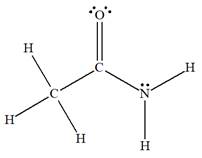
Explanation of Solution
The given species is:
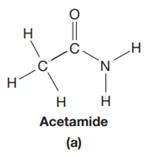
The formula for the species above is
The carbon atom on the left side has four bonds, thus, its octet is complete. The carbon atom in the middle has four bonds, hence, its octet is also complete. The nitrogen atom has three bonds, thus, its octet is not complete. There should be one lone pair of electron on nitrogen. The double bonded oxygen atom has got two bonds. Thus, in order to complete its octet, it should possess two lone pair of electrons. Thus, all the
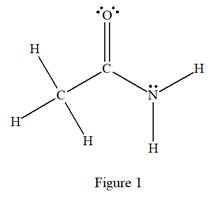
The complete Lewis structure for the given species including multiple bonds and lone pairs is shown in Figure 1 above.
(b)
Interpretation:
For given species, the complete Lewis structure is to be completed by adding multiple bonds and/or lone pairs.
Concept introduction:
In order to draw a Lewis structure for a molecule, start by counting the total number of valence electrons in a molecule. The number of valence electrons by each atom is the same as its group number. For a charged species, each negative charge increases the number of valence electrons by one while each positive charge decreases the number of valence electrons by one. For the given skeleton of the molecule, distribute the remaining electrons as lone pairs. In doing so, start with the outer atoms and work inwards. Try to achieve an octet on each atom other than hydrogen. If there is an atom with less than an octet, increase the atom’s share of electrons by converting lone pairs from neighboring atoms to bonding pairs thereby creating double or triple bonds. For an uncharged atom, carbon atoms will have maximum of four bonds. Nitrogen will have three bonds and one lone pair, while oxygen will have two bonds and two lone pairs. Hydrogen always contributes to one bond. The number of bond in case of halogen is one, while there will be three lone pair of electrons on halide atoms.
Answer to Problem 1.24P
The complete Lewis structure for the given species is:

Explanation of Solution
The given species is:
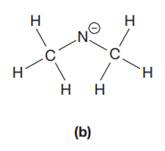
The formula for the species above is
The carbon atom on the left as well as on the right has four bonds, thus, their octets are complete. The nitrogen atom has two bonds and a negative formal charge. This suggests that the remaining four electrons should be present on the nitrogen atom so as to complete its octet and have a negative formal charge. Thus, the complete Lewis structure for the given species is:
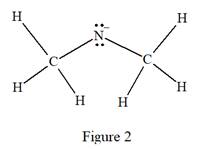
The complete Lewis structure for the given species including multiple bonds and lone pairs is shown in Figure 2 above.
(c)
Interpretation:
For given species, the complete Lewis structure is to be completed by adding multiple bonds and/or lone pairs.
Concept introduction:
In order to draw a Lewis structure for a molecule, start by counting the total number of valence electrons in a molecule. The number of valence electrons by each atom is the same as its group number. For a charged species, each negative charge increase the number of valence electrons by one while each positive charge decrease the number of valence electrons by one. For the given skeleton of the molecule, distribute the remaining electrons as lone pairs. In doing so, start with the outer atoms and work inwards. Try to achieve an octet on each atom other than hydrogen. If there is an atom with less than an octet, increase the atom’s share of electrons by converting lone pairs from neighboring atoms to bonding pairs thereby creating double or triple bonds. For an uncharged atom, carbon atoms will have maximum of four bonds. Nitrogen will have three bonds and one lone pair, while oxygen will have two bonds and two lone pairs. Hydrogen always contributes to one bond. The number of bond in case of halogen is one, while there will be three lone pair of electrons on halide atoms.
Answer to Problem 1.24P
The complete Lewis structure for the given species is:
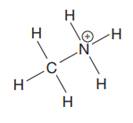
Explanation of Solution
The given species is:
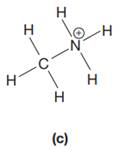
The formula for the species above is
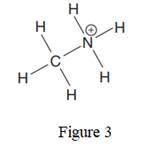
The complete Lewis structure for the given species including multiple bonds and lone pairs is shown in Figure 2 above.
(d)
Interpretation:
For given species, the complete Lewis structure is to be completed by adding multiple bonds and/or lone pairs.
Concept introduction:
In order to draw a Lewis structure for a molecule, start by counting the total number of valence electrons in a molecule. The number of valence electrons by each atom is the same as its group number. For a charged species, each negative charge increase the number of valence electrons by one while each positive charge decrease the number of valence electrons by one. For the given skeleton of the molecule, distribute the remaining electrons as lone pairs. In doing so, start with the outer atoms and work inwards. Try to achieve an octet on each atom other than hydrogen. If there is an atom with less than an octet, increase the atom’s share of electrons by converting lone pairs from neighboring atoms into bonding pairs thereby creating double or triple bonds. For an uncharged atom, carbon atoms will have maximum of four bonds. Nitrogen will have three bonds and one lone pair, while oxygen will have two bonds and two lone pairs. Hydrogen always contributes to one bond. The number of bond in case of halogen is one, while there will be three lone pair of electrons on halide atoms.
Answer to Problem 1.24P
The complete Lewis structure for the given species is:
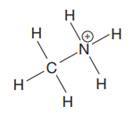
Explanation of Solution
The given species is:

The formula for the species above is

The complete Lewis structure for the given species including multiple bonds and lone pairs is shown in Figure 4 above.
Want to see more full solutions like this?
Chapter 1 Solutions
EBK ORGANIC CHEMISTRY: PRINCIPLES AND M
- Write the electron configuration of an atom of the element highlighted in this outline of the Periodic Table: 1 23 4 5 6 7 He Ne Ar Kr Xe Rn Hint: you do not need to know the name or symbol of the highlighted element! ☐arrow_forwardCompare these chromatograms of three anti-psychotic drugs done by HPLC and SFC. Why is there the difference in separation time for SFC versus HPLC? Hint, use the Van Deemter plot as a guide in answering this question. Why, fundamentally, would you expect a faster separation for SFC than HPLC, in general?arrow_forwardA certain inorganic cation has an electrophoretic mobility of 5.27 x 10-4 cm2s-1V-1. The same ion has a diffusion coefficient of 9.5 x 10-6cm2s-1. If this ion is separated from cations by CZE with a 75cm capillary, what is the expected plate count, N, at an applied voltage of 15.0kV? Under these separation conditions, the electroosmotic flow rate was 0.85mm s-1 toward the cathode. If the detector was 50.0cm from the injection end of the capillary, how long would it take in minutes for the analyte cation to reach the detector after the field was applied?arrow_forward
- 2.arrow_forwardPlease solve for the following Electrochemistry that occursarrow_forwardCommercial bleach contains either chlorine or oxygen as an active ingredient. A commercial oxygenated bleach is much safer to handle and less likely to ruin your clothes. It is possible to determine the amount of active ingredient in an oxygenated bleach product by performing a redox titration. The balance reaction for such a titration is: 6H+ +5H2O2 +2MnO4- à 5O2 + 2Mn2+ + 8H2O If you performed the following procedure: “First, dilute the Seventh Generation Non-Chlorine Bleach by pipetting 10 mL of bleach in a 100 mL volumetric flask and filling the flask to the mark with distilled water. Next, pipet 10 mL of the diluted bleach solution into a 250 mL Erlenmeyer flask and add 20 mL of 1.0 M H2SO4 to the flask. This solution should be titrated with 0.0100 M KMnO4 solution.” It took 18.47mL of the KMnO4 to reach the endpoint on average. What was the concentration of H2O2 in the original bleach solution in weight % assuming the density of bleach is 1g/mL?arrow_forward
- 10.arrow_forwardProper care of pH electrodes: Why can you not store a pH electrode in distilled water? What must you instead store it in? Why?arrow_forwardWrite the electron configuration of an atom of the element highlighted in this outline of the Periodic Table: 1 23 4 569 7 He Ne Ar Kr Xe Rn Hint: you do not need to know the name or symbol of the highlighted element! §arrow_forward
- Identify the amino acids by name. Illustrate a titration curve for this tetrapeptide indicating the pKa's for each ionizable groups and identify the pI for this tetrapeptide. please helparrow_forward↓ ina xSign x Sign X labs X Intro X Cop Xa chat X My Cx Grac X Laur x Laur xash learning.com/ihub/assessment/f188d950-dd73-11e0-9572-0800200c9a66/d591b3f2-d5f7-4983-843c-0d00c1c0340b/f2b47861-07c4-4d1b-a1ee-e7db2 +949 pts /3400 K Question 16 of 34 > © Macmillan Learning Draw the major E2 reaction product formed when cis-1-chloro-2-ethylcyclohexane (shown) reacts with hydroxide ion in DMSO. H CH2CH3 H H HO- H H H Cl DMSO H H C Select Draw Templates More C H 0 2 Erasearrow_forwardA common buffer for stabilizing antibodies is 100 mM Histidine at pH 7.0. Describe the preparation of this buffer beginning with L-Histidine monohydrochloride monohydrate and 1 M NaOH. Be certain to show the buffering reaction that includes the conjugate acid and base.arrow_forward
 Organic Chemistry: A Guided InquiryChemistryISBN:9780618974122Author:Andrei StraumanisPublisher:Cengage Learning
Organic Chemistry: A Guided InquiryChemistryISBN:9780618974122Author:Andrei StraumanisPublisher:Cengage Learning Introductory Chemistry: An Active Learning Approa...ChemistryISBN:9781305079250Author:Mark S. Cracolice, Ed PetersPublisher:Cengage Learning
Introductory Chemistry: An Active Learning Approa...ChemistryISBN:9781305079250Author:Mark S. Cracolice, Ed PetersPublisher:Cengage Learning


